第8章战略管理罗宾斯管理学第8版讲义全集,英文版
- 格式:ppt
- 大小:2.08 MB
- 文档页数:10
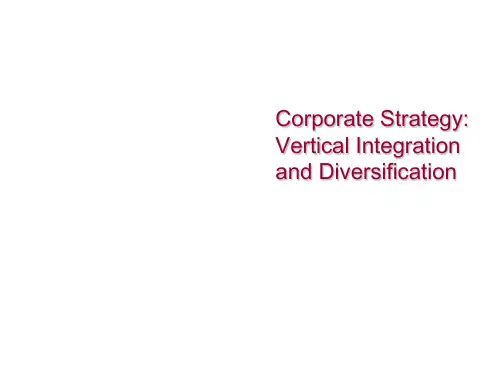
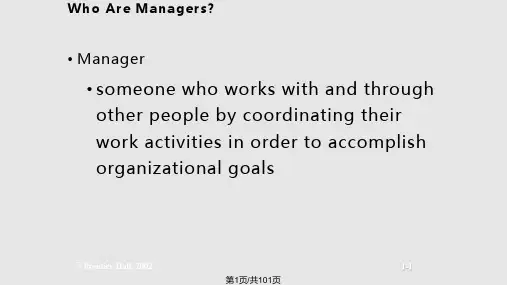
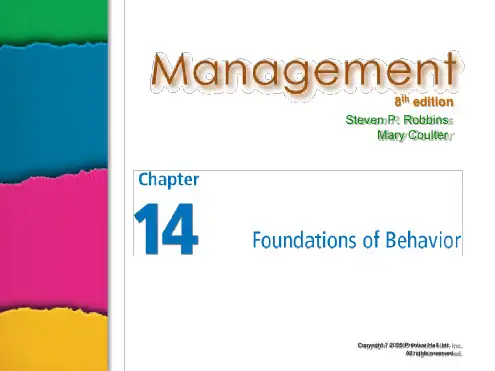
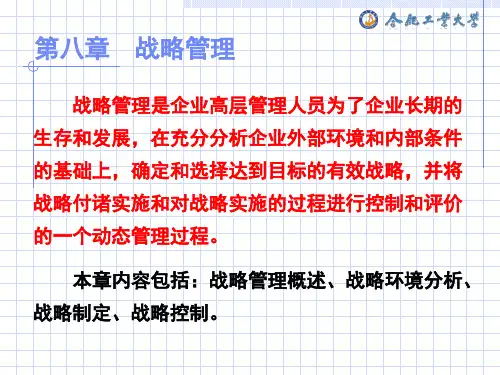
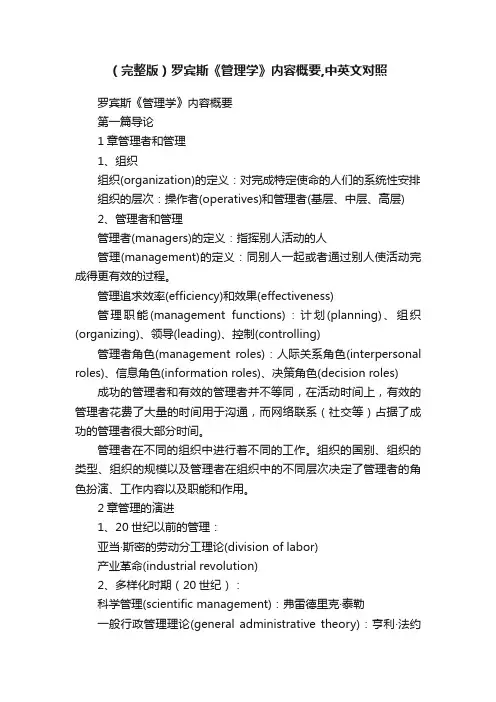
(完整版)罗宾斯《管理学》内容概要,中英文对照罗宾斯《管理学》内容概要第一篇导论1章管理者和管理1、组织组织(organization)的定义:对完成特定使命的人们的系统性安排组织的层次:操作者(operatives)和管理者(基层、中层、高层)2、管理者和管理管理者(managers)的定义:指挥别人活动的人管理(management)的定义:同别人一起或者通过别人使活动完成得更有效的过程。
管理追求效率(efficiency)和效果(effectiveness)管理职能(management functions):计划(planning)、组织(organizing)、领导(leading)、控制(controlling)管理者角色(management roles):人际关系角色(interpersonal roles)、信息角色(information roles)、决策角色(decision roles) 成功的管理者和有效的管理者并不等同,在活动时间上,有效的管理者花费了大量的时间用于沟通,而网络联系(社交等)占据了成功的管理者很大部分时间。
管理者在不同的组织中进行着不同的工作。
组织的国别、组织的类型、组织的规模以及管理者在组织中的不同层次决定了管理者的角色扮演、工作内容以及职能和作用。
2章管理的演进1、20世纪以前的管理:亚当·斯密的劳动分工理论(division of labor)产业革命(industrial revolution)2、多样化时期(20世纪):科学管理(scientific management):弗雷德里克·泰勒一般行政管理理论(general administrative theory):亨利·法约尔(principles of management)、马克斯·韦伯(bureaucracy) 人力资源方法(human resources approach):权威的接受观点(acceptance view of authority),霍桑研究,人际关系运动(卡内基、马斯洛),行为科学理论家(behavioral science theorists) 定量方法(quantitative approach)3、近年来的趋势(20世纪后期):趋向一体化过程方法(process approach)系统方法(systems approach):封闭系统和开放系统(closed systems)权变方法(contingency approach):一般性的权变变量包括组织规模、任务技术的例常性、环境的不确定性、个人差异4、当前的趋势和问题(21世纪):变化中的管理实践全球化(globalization)工作人员多样化(work force diversity)道德(morality)激励创新(innovations)和变革(changes)全面质量管理(total quality management, TQM):由顾客需要和期望驱动的管理哲学授权(delegation)工作人员的两极化(bi-modal work force)3章组织文化与环境:管理的约束力量1、组织组织文化(organizational culture)被用来指共有的价值体系。
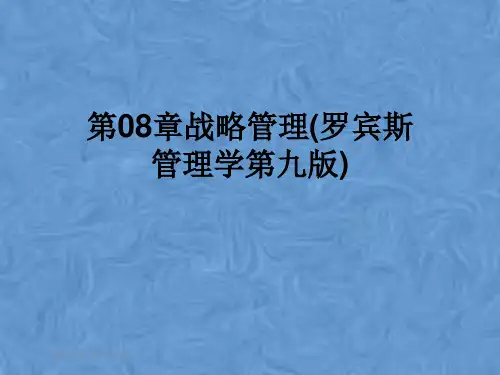
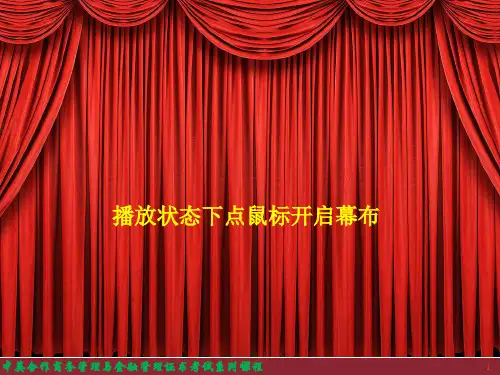
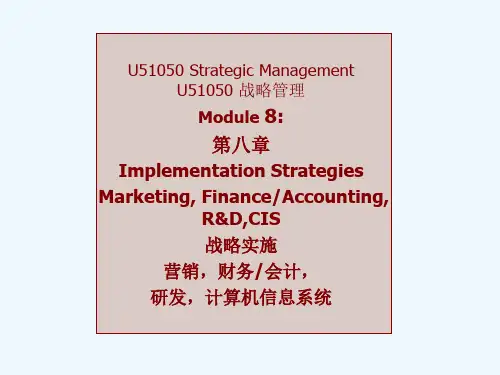
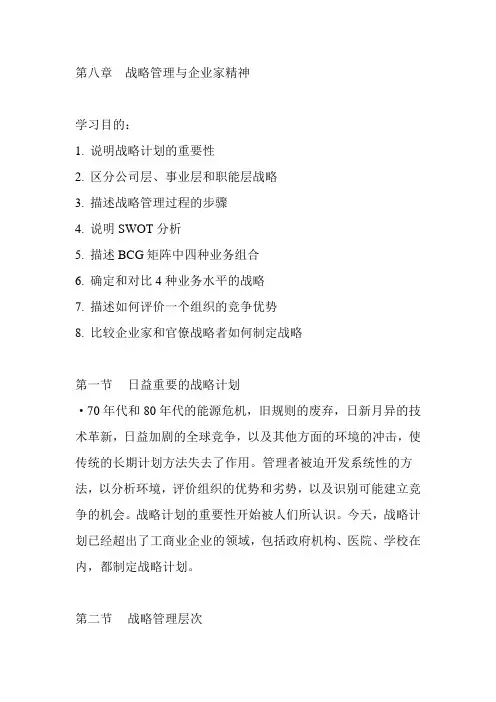
第八章战略管理与企业家精神学习目的:1.说明战略计划的重要性2.区分公司层、事业层和职能层战略3.描述战略管理过程的步骤4.说明SWOT分析5.描述BCG矩阵中四种业务组合6.确定和对比4种业务水平的战略7.描述如何评价一个组织的竞争优势8.比较企业家和官僚战略者如何制定战略第一节日益重要的战略计划·70年代和80年代的能源危机,旧规则的废弃,日新月异的技术革新,日益加剧的全球竞争,以及其他方面的环境的冲击,使传统的长期计划方法失去了作用。
管理者被迫开发系统性的方法,以分析环境,评价组织的优势和劣势,以及识别可能建立竞争的机会。
战略计划的重要性开始被人们所认识。
今天,战略计划已经超出了工商业企业的领域,包括政府机构、医院、学校在内,都制定战略计划。
第二节战略管理层次一.公司层战略1.公司层战略【corporate-level strategy】:寻求确定公司应当从事何种事业。
2.如果一个组织拥有一种以上的事业,就需要一种公司层战略。
这种战略寻求回答这样的问题:我们应当拥有什么样的事业组合?公司层战略应当决定每一种战略在组织中的地位。
二.事业层战略1.事业层战略【business-level strategy】:寻求决定公司应当如何在其每一个事业领域内开展竞争。
对于只从事一种事业的组织,公司层战略与事业层战略是一回事。
对于拥有多种事业的组织,每一个经营部门都有自己的战略,这种战略规定该经营单位提供的产品或服务,以及向那些顾客提供产品或服务,等等。
2.战略事业单位【strategic business unit SBU】:一项单独的事业或事业组合,独立经营和制定自己的战略。
当一个组织拥有多种不同事业时,建立战略事业单位更便于计划和控制。
3.计划的战略事业单位应按照以下原则划分事业单位:组织的经营可以看作是一种事业组合,每一个事业单位服务于明确定义的产品——细分市场,并具有明确定义的战略。
事业组合中的每一个事业单位按照自身的能力和竞争需要开发自己的战略,同时必须与组织整体的能力和需要保持一致。
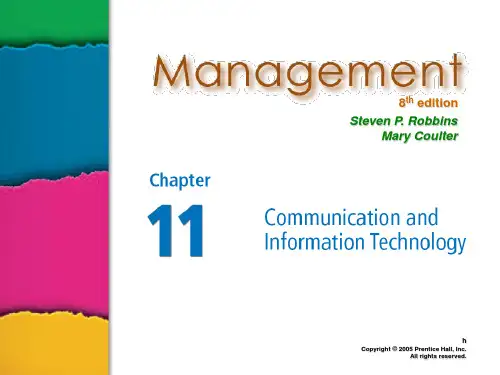

EightStrategic Management1. INTRODUCTION.Effective managers recognize the role that strategic management plays in their organization’s performance. An underlying theme of this chapter is that good strategies can lead to high organizational performance.2. THE IMPORTANCE OF STRATEGIC MANAGEMENT.The role that the environment plays has influenced managers in developing a systematic means of analyzing the environment, assessing their organization’s strengths and weaknesses, identifying opportunities that would give the organization a competitive advantage, and incorporating these findings into their planning. The value of thinking strategically has an important impact on organization performance.A. What is strategic management?1. Strategic management is that set of managerial decisions andactions that determines the long-run performance of anorganization.2. It entails all of the basic management functions—planning,organizing, leading, and controlling.B. Why is Strategic Management Important?1. One reason strategic management is important is because it canmake a difference in how well an organization performs.2. Another reason has to do with the fact that organizations of alltypes and sizes face continually changing situations.3. Strategic management is also important because of the nature oforganizations. They are composed of diverse divisions, units,functions and work activities that need to be coordinated.4. Strategic management is also important because it’sinvolved in many of the decisions that managers make.3. THE STRATEGIC MANAGEMENT PROCESS.The strategic management process is s six-step process that encompasses strategic planning, implementation, and evaluation. (See Exhibit 8.1)A. Step 1: Identifying the Organization’s Curre nt Mission, Objectives, andStrategies.1.Every organization needs a mission,which defines the purpose ofthe organization. What is the organization’s reason for being inbusiness? Exhibit 8.2 describes some common components found inorganizational mission statements.2. It’s also important to identify the organization’s currentobjectives and strategies, as well.B. Step 2: External Analysis.1. Managers in every organization need to do an external analysis.Factors such as competition, pending legislation, and laborsupply could have an impact.2. After analyzing the environment, managers need to assess whatthey have learned in terms of opportunities and threats.Opportunities are positive trends in external environmentalfactors; threats are negative trends.3. The same environment can present opportunities to oneorganization and pose threats to another in the same industrybecause of different resources and capabilities.C. Step 3: Internal Analysis.1. Should lead to a clear assessment of the organi zation’s resourcesand capabilities.2. Any activities the organization does well or any uniqueresources that it has are called strengths.3. Weaknesses are activities the organization does not do well orresources it needs but does not possess.If any of the organizational capabilities or resources areexceptional or unique, they’re called the organization’s corecompetencies.anizational culture is important in internal analysis. It canpromote or hinder an organization’s strategic actions.5. Combined external and internal analyses are called SWOTanalysis because it’s an analysis of the organizations’ strengths,weaknesses, opportunities and threats.D. Step 4: Formulating Strategies.1. After the SWOT, managers develop and evaluate strategicalternatives and select strategies that are appropriate.2. Strategies need to be established for corporate, business andfunctional levels.E. Step 5: Implementing Strategies.1. A strategy is only as good as it implementation.F.Step 6:Evaluating Results.1. How effective have the strategies been? Are adjustmentsnecessary?4. TYPES OF ORGANIZATIONAL STRATEGIES.There are three different and distinct levels of strategy: corporate, business, and functional. (See Exhibit 8.4)A. Corporate Level StrategyThe corporate-level strategy seeks to determine what businesses acorporation should be in or wants to be in.1.Three main corporate strategies:a.Growth: growth strategy seeks to increase theorganization’s business by expanding the number ofproducts offered or markets served.b.Stability. A stability strategy is characterized by anabsence of significant change.c.Renewal. Renewal strategies are deployed when theorganization is in trouble. Two such strategies areretrenchment strategy and turnaround strategy.1.Corporate Portfolio Analysis. Used when an organization’scorporate strategy involves a number of businesses.a.BCG Matrix helps to identify which businesses offer highpotential and which are a drain on organizational resources. B.Business-Level StrategySeeks to determine how an organization should compete in each of itsbusinesses.1.The Role of Competitive Advantage. Competitive advantage iswhat sets an organization apart, that is, its distinct edge. Thesecome from the firm’s core co mpetencies.2.Quality as a Competitive Advantage. If implemented properly,quality can be a way for an organization to create a sustainablecompetitive advantage.1. Sustaining Competitive Advantage. Enables the organization tokeep its edge despi te competitors’ actions or evolutionarychanges in the industry.4. Competitive strategies developed out of the work of MichaelPorter. His framework suggests that managers can choose fromamong three generic strategies. Porter’s major contribution hasbeen to carefully outline how managers can create and sustain acompetitive strategy in order to earn above-average profitability.a. Industry analysis is an important step in Porter’sframework. He says there are five competitive forces atwork in an industry. (See Exhibit 8.7).1) Threat of new entrants is determined by barriersto entry, which are factors that determine howeasy or hard it is for new competitors to enter anindustry.2) Bargaining power of buyers are factors thatdetermine the amount of influence that buyershave in an industry.3) Threat of substitutes is a factor that determineswhether or not customers will switch theirbusiness to a competitor.4) Bargaining power of suppliers are forces thatdetermine the power that suppliers have overfirms in the industry.5) Existing rivalry includes factors that determinehow intense the competitive rivalry will beamong firms currently in the industry.5. Porter then goes on to state that management must choose astrategy that will give it a competitive advantage over its rivals.There are three generic competitive strategies. Which onemanagers select depends on the organization’s strengths andcore competencies and its competitors’ weaknesses.a. A cost leadership strategy is the strategy anorganization follows when it wants to be the lowest-costproducer in the industry.b. The differentiation strategy is the strategy a firmfollows when it wants to be unique in its industry alongdimensions valued by buyers.c. The focus strategy is the strategy a company followswhen it pursues a cost or differentiation advantage in anarrow industry segment.6. Porter proposed that a firm could not successfully pursue acombination of these competitive strategies and used the termstuck in the middle to describe organizations that cannotcompete through cost leadership, differentiation, or focusstrategies.7. However, a growing number of research studies have shown thata dual emphasis on low costs and differentiation can result inhigh performance. This app roach isn’t easy to implement,however.C. Functional Level StrategyThe functional-level strategy seeks to determine how to support thebusiness-level strategy.B. New Directions in Organizational Strategies.1. Strategies for Applying e-Business Techniques. Using theInternet, companies have created knowledge bases thatemployees can tap into anytime, anywhere. E-Business as astrategy can develop a sustainable competitive advantage, beused as a differentiator, or act as a focuser.2. Customer Service Strategies. These strategies give customerswhat they want, communicate effectively with them, and provideemployees with customer service training.3. Innovation Strategies. Can focus on breakthrough products orthen can include the application of existing technology to newuses. An organization that is first to bring a product innovationto the market or to use a new process innovation is called a firstmover.1. Perform a SWOT analysis on a local business you think you know well. What, ifany, competitive advantage has this organization staked out?Answers to this question will vary. Depending on the number of “available”businesses to study, you might need to assign this question to teams of students.Encourage them to thoroughly cover each area of the SWOT. To save time and hassle, you might want to discuss with students ways to find information for doing a SWOT before sending them out to do this assignment.2. How might the processes of strategy formulation, implementation, andevaluation differ for (a) large businesses, (b) small businesses, (c) not-for-profit organizations, and (d) global businesses?Hopefully, students will recognize that the processes of strategy formulation, implementation, and evaluation won’t differ for these differe nt types of organizations, but the content of the processes will very likely differ.3.“The concept of competitive advantage is as important for not-for-profitorganizations as it is for for-profit organization.” Do you agree or disagree with this statement? Explain, using examples to make your case.Students should be able to recognize that although the not-for-profit organizations are not attempting to make a profit, they are attempting to be successful and remain productive, and that the correct strategy is what will allow this existence.4. Should ethical considerations be included in the analyses of an organization’sinternal and external environments? Why or why not?Ethical considerations should be included in every activity of an organization.Another question to pose to students is what would ethical considerations include?5. How could the Internet be helpful to managers as they follow the steps in thestrategic management process?The Internet allows the manager access to so much more information almost instantaneously about competitors, environmental factors, and customers. This information improves the manager’s ability to make sound strategic management decisions.6.Find examples of five different organizational mission statements. Using themission statements, describe what types of corporate-level and business-level strategies each organization might use to fulfill that mission statement. Explain your rationale for choosing each strategy.Students will select a wide range of companies and mission statements. This is an excellent opportunity for students to differentiate between corporate-level and business-level strategies. You may want to “assign” at least one firm that has several business units associated with it.。